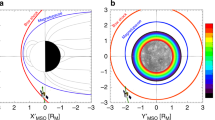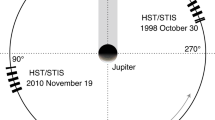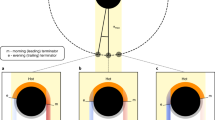Abstract
The discovery of a column density of neutral sodium vapour (∼1011–1012 atoms Na cm−2) associated with the solar-facing side of the planet Mercury1 has rekindled interest in the possible presence of atmospheric gases on that planet. Recent observations2 confirm the presence of Na emission, with its centroid shifted to the sunward limb. The sodium fluorescence is observed in the visible range. Previous ultraviolet observations by Mariner 10 provided evidence for the presence of H and He in the atmosphere (∼1011 and 1012 atoms cm−2 respectively3) and gave upper limits on other possible species (such as O, Ne, Ar and C). Whereas the H and He can be explained primarily by capture from the solar wind4, we show here that this is not so for Na by evaluating the depletion rates. Photon and ion bombardment can release Na from its normal bonding state, producing adsorbed and ejected Na in ballistic trajectories. We show that ion sputtering cannot account for the observed column density but is an important loss mechanism for Na. Photons are likely to be the dominant stimulus, both directly through photodesorption and indirectly through thermal desorption of absorbed Na. We therefore conclude that the atmosphere produced is characterized by the planet's surface temperature, with the ion-sputtered Na contributing to a lesser, but more extended, component of the atmosphere.
This is a preview of subscription content, access via your institution
Access options
Subscribe to this journal
Receive 51 print issues and online access
$199.00 per year
only $3.90 per issue
Buy this article
- Purchase on Springer Link
- Instant access to full article PDF
Prices may be subject to local taxes which are calculated during checkout
Similar content being viewed by others
References
Potter, A. & Morgan, T. Science 229, 651–653 (1985).
Schneider, N. M., Wells, W. K. & Hunten, D. M. Bull. Am. astr. Soc. 17, 712 (1985).
Broadfoot, A. L., Kumar, S., Belton, M. J. & McElroy, M. B. Science 185, 166–169 (1974).
Goldstein, B. E., Seuss, S. T. & Walker, R. J. J. geophys. Res. 86, 5485–5499 (1981).
Vinogradov, A. P. in Cosmochemistry of the Moon and Planets, NASA spec. Publ. No. 370 (PI), 5–33 (1977).
Murti, D. K. & Kelly, R. Thin solid Films 33, 149–163 (1976).
Miotello, A. & Mazoldi, P. Phys. Rev. Lett. 54, 1675–1678 (1985).
Cassidy, W. & Hapke, B. Icarus 25, 371–383 (1975).
Hapke, B. Icarus 66, 270–279 (1986).
Johnson, R. E. & Brown, W. L. Nucl. Instr. Meth. 198, 103–118 (1982).
Sigmund, P. in Sputtering by Ion Bombardment Vol. 1 (ed. Berisch, E.) 9–71 (Springer, New York, 1981).
Johnson, R. E., Lanzerotti, L. J. & Brown, W. L. Adv. Space Res. 4, 9, 41–51 (1984).
Haglund, R. F. et al. Nucl. Instr. Meth. (in the press).
Tolk, N. & Larchuk, T. S. Inst. Phys. Conf. Ser. no. 71, 135–141 (1984).
Leung, C., Vass, M. & Gomer, R. Surf. Sci. 66, 67–71 (1977).
Kirchoff, V. W. Geophys. Res. Lett. 10, 721–724 (1983).
Kelly, R. Surf. Sci. 90, 380–318 (1979).
Evans, B. L., Yoeff, A. D. & Gray, P. Chem. Rev. 59, 515–568 (1959).
Swider, W. Planet. Space Sci. 17, 1233–1246 (1969).
Carlson, R. W., Matson, D. L. & Johnson, T. V. Geophys. Res. Lett. 2, 469–471 (1985).
Smyth, W. H. Bull. Am. astr. Soc. 17, 712 (1985); Nature 323, 696–699 (1986).
Ip, W -H. Geophys. Res. Lett. 13, 423–426 (1986).
Shemansky, D. D. & Broadfoot, A. L. Rev. Geophys. Space Phys. 15, 491–499 (1977).
Simpson, J. A., Eraker, J. H., Lamport, J. E. & Walpole, P. H. Science 85, 160–166 (1974).
Kirsch, E. & Richter, A. K. Ann. Geophys. 3, 13–18 (1985).
Kumar, S. Icarus 28, 579–591 (1976).
Geiss, J. in Proc. ESA Workshop on Future Missions in Solar, Heliospheric, and Space Plasma Physics, ESA SP-235, 37–50 (1985).
Kunz, S., Bochsler, P., Geiss, J., Ogilvie, K. W. & Caplan, M. A. Sol. Phys. 88, 359–376 (1983).
Bame, S. J., Asbridge, J. R., Feldman, W. C., Montgomery, M. D. & Kearney, P. D. Sol. Phys. 43, 463–473 (1975).
Author information
Authors and Affiliations
Rights and permissions
About this article
Cite this article
McGrath, M., Johnson, R. & Lanzerotti, L. Sputtering of sodium on the planet Mercury. Nature 323, 694–696 (1986). https://doi.org/10.1038/323694a0
Received:
Accepted:
Issue Date:
DOI: https://doi.org/10.1038/323694a0
This article is cited by
-
Surface Exospheric Interactions
Space Science Reviews (2023)
-
Review of Mercury’s dynamic magnetosphere: Post-MESSENGER era and comparative magnetospheres
Science China Earth Sciences (2022)
-
Comparative Na and K Mercury and Moon Exospheres
Space Science Reviews (2022)
-
Space Weather at Comet 67P/Churyumov–Gerasimenko Before its Perihelion
Earth, Moon, and Planets (2016)
-
Plasma Sources in Planetary Magnetospheres: Mercury
Space Science Reviews (2015)
Comments
By submitting a comment you agree to abide by our Terms and Community Guidelines. If you find something abusive or that does not comply with our terms or guidelines please flag it as inappropriate.



